Image Format - Arnold for Houdini
The Image format control allows you to choose between the available Arnold output driver nodes. The options vary slightly depending on the output driver.
- OpenEXR
- Deep OpenEXR
- JPEG
- PNG
- TIFF
OpenEXR

| Tiling | Allows you to save the file in scanline or tiled mode. Scanline may work better with composition packages like Nuke or Fusion. If tiled is off the whole image buffer size will be allocated all at once for all the AOVs present in the scene. If enabled, Arnold will save the buckets as they are rendered, which reduces memory taken up by image buffers. |
| Compression | Specifies the compression mode of the file. |
| Color Space | Specifies which color space to use for rendered images. Built-in values are linear sRGB and Rec709. The default value auto will use sRGB for 8-bit formats and linear otherwise. |
| Half Precision for Beauty | Stores the beauty layer as half-precision (16-bit floating point) instead of 32-bit floats. Use this when you want to mix half- and full-float AOVs. |
| Half Precision | Specify whether 16-bit floating-point (binary16) is used (as opposed to full 32-bit precision). This provides a sufficient degree of precision in many cases while keeping data usage down. |
| Multipart | The EXR driver can render AOVs as separate images (parts) in a multi-part EXR file (merged AOVs, in contrast, renders AOVs as layers in a single-part EXR). Multi-part works with either scanline or tiled EXRs and is enabled with the driver_exr.multipart boolean parameter. * Noice does not work with multi-part EXRs. |
| Preserve Layer Name | If checked, the data of the different AOVs will be stored in the EXR in layers with the names of the AOV, and not the RGB. |
| Autocrop | Autocrop removes pixels where alpha and all other channels are zero. It contains a bounding box around the content of the image, which informs a compositing application which part of the image needs to be identified and which part can be skipped. This is particularly useful when you have a CG element that is not filling the whole frame (see image below). Only a small part of the image will be processed in the compositing application. Therefore it will only load the data window and skip the rest. 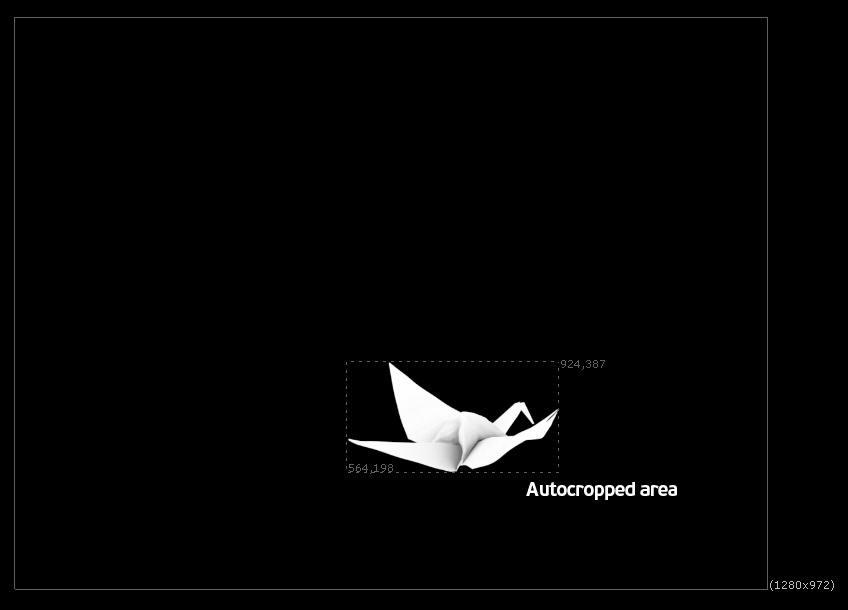 The autocropped area that has been identified in a compositing application The autocropped area that has been identified in a compositing application |
| Append | This option enables render check-pointing (or 'append mode'). By setting the corresponding output driver's .append attribute to true, Arnold will preserve previously rendered tiles and only work on the missing ones, appending them to the output files. If no image is present, the render will proceed as normal, creating a new image. If image specifications do not match, the render will be aborted. |
| Metadata | Allows custom attributes to be added as EXR metadata. Supported types are int, float, point2, matrix, and string. For example: 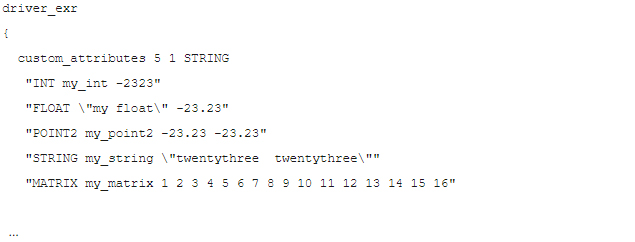 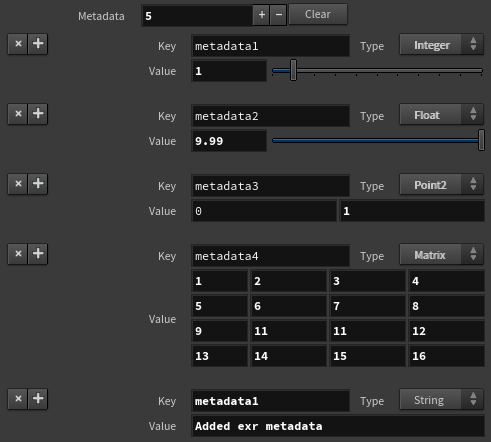 |
| Layer Name | Output layer names can be customized by adding an optional custom layer name after the driver name. Output layers in files that support layers (such as regular or deep EXR files) can be individually set to type 'HALF' by adding an optional 'HALF' modifier to the corresponding output string. For instance: "my_aov RGB filter driver HALF". |
Deep OpenEXR
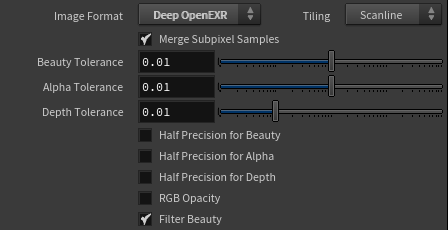
Deep EXR files store a variable-length list of samples stored with multiple values at different depths for each pixel.
Layer Name
Output layer names can be customized by adding an optional custom layer name after the driver name. Output layers in files that support layers (such as regular or deep EXR files) can be individually set to type 'HALF' by adding an optional 'HALF' modifier to the corresponding output string. For instance: "my_aov RGB filter driver HALF".

JPEG

| Color Space | Specifies which color space to use for rendered images. Built-in values are linear sRGB and Rec709. The default value auto will use sRGB for 8-bit formats and linear otherwise. |
| JPEG Quality | The JPEG quality setting (a quality/compression trade-off, with 100 giving the least compression/highest quality). |
| Dithering | Applies a small amount of noise to the final pixel values. This helps minimize banding artifacts apparent on 8-bit output image file formats. |
PNG

| Pixel Format | The format of the PNG file (8 bit or 16 bits per channel). |
| Color Space | Specifies which color space to use for rendered images. Built-in values are linear sRGB and Rec709. The default value auto will use sRGB for 8-bit formats and linear otherwise. |
| Dithering | Applies a small amount of noise to the final pixel values. This helps minimize banding artifacts apparent on 8-bit output image file formats. |
TIFF
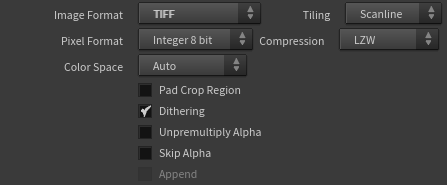
| Tiling | Allows you to save the file in scanline or tiled mode. Scanline may work better with composition packages like Nuke or Fusion. If tiled is off the whole image buffer size will be allocated all at once for all the AOVs present in the scene. If enabled, Arnold will save the buckets as they are rendered, which reduces memory taken up by image buffers. |
| Pixel Format | Specify whether 8, 16, 32 bit or floating point is used. |
| Compression | Specifies the compression mode of the file. |
| Color Space | Specifies which color space to use for rendered images. Built-in values are linear sRGB and Rec709. The default value auto will use sRGB for 8-bit formats and linear otherwise. |
| Dithering | Applies a small amount of noise to the final pixel values. This helps minimize banding artifacts apparent on 8-bit output image file formats. |
| Unpremultiply Alpha | Specifies whether the main RGB channel is premultiplied with the alpha channel (the default) or not. It only works with 8-bit output images. |
| Skip Alpha | No alpha channel will be included when the file is written out. |
| Append | This option enables render check-pointing (or 'append mode'). By setting the corresponding output driver's .append attribute to true, Arnold will preserve previously rendered tiles and only work on the missing ones, appending them to the output files. If no image is present, the render will proceed as normal, creating a new image. If image specifications do not match, the render will be aborted. |

